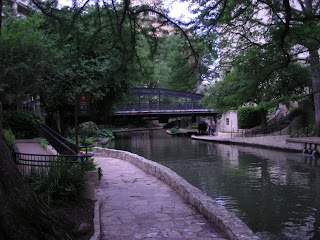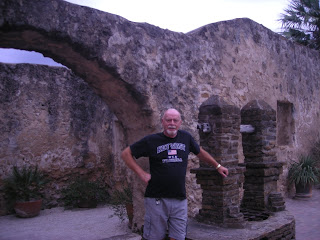Sunday, April 22, 2012
San Antonio River Walk and The Mission District
On April 16th, we toured the River walk. This is a section of the river that is populated by bars, hotels and restaurants, all set in relaxing surroundings. We also toured the missions district, with San Juan Capistrano, San Jose, and other ancient missions. Her are some pictures from this tour:
History of the River Walk
In Texas, water has been a lifeline for many generations for centuries past. The San Antonio River is a source of a South Texas Treasure, The San Antonio River Walk. Development of San Antonio and its most popular tourism attraction has come a long way.
1691
June 13. Domingo Teran de los Rios, first Governor of the new Province of Texas, accompanies Father Damian Massanet on his return trip to East Texas. Camping at a rancheria of Payaya Indians on a stream called Yanaguana, someone said "let's celebrate mass and rename the stream 'San Antonio' because it is Saint Anthony’s day"
1718
Martin de Alarcon, Governor of Texas, names the presidio San Antonio de Bejar in honor of the Duque de Bejar, The Mission of San Francisco de Solano is moved from the Rio Grande to merge with Mission San Antonio de Padua. The mission is renamed Mission San Antonio de Valero. The presidio, the villa and the mission comprise the municipality named San Antonio de los Llanos (of the Plains) by Governor Alarcon.
1792
All the missions are closed down by order of the Spanish government. Their lands are distributed to the mission Indians attached to the compounds
Through the late 1800s and early 1900s, San Antonio's growing population and expanding boundaries were the cause, to a large degree, of problems brought about by flooding. In fact, if steps to control the flooding had not been taken in the 1920’s, later commercial development along the river would not have been possible.
1845-1848
The Mexican War. The Treaty of Guadalupe-Hidalgo is signed in Queretaro. Mexico cedes Texas, California, New Mexico and most of Arizona to the United States for $18,250,000. The Texas border was established by this treaty as the Rio Grande.
1861-1865
U.S. Civil War
1929
June 28. Robert H. Hugman presents his plan for 'The Shops of Romula and Aragon' to Mayor Chambers, two city commissioners, property owners and civic leaders. The proposal endorses the bypass channel and recommends flood gates at the north end, a small dam at the south end and a tainter gate in the channel to check the flow and create pools of water. Bypass channel completed, but the Depression prevents further expenditures.
1936
Texas Centennial. Jack White, owner of the White Plaza Hotel, visits City Hall to urge clean-up and beautification of the river. White and the Mexican Businessmen's Association stage 'A Venetian Night' on the river- the first river parade.
1938
The full esthetic potential of the river becomes recognized. Congressman Maury Maverick, Mayor C.K. Quin and a group of citizens, headed by White, push for development of the river. October 25. A special election is called to approve a tax of .015 cents per $100 valuation to raise the $75,000 needed to leverage $325,000 in WPA funds for river work. The tax passes 74-2. 71 voters live in White's hotel.
1961
Marco Engineering Company of California, major designers of Disneyland, complete a report, funded by the City and the Chamber, on the commercial potential of the river. The plan suggests that all buildings which back up to the river be developed in an early Texas or Mexican colonial style, and that as many as possible be rehabilitated to provide basement space that would open at the River Walk level to accommodate retail and entertainment facilities. Criticism arises over the carnival-like aspects of the plan, but other elements, like forming a merchants' association and holding frequent festivals are used as a basis for further plan development.
1962
Straus, along with Harold Robbins and Jimmy Gause from the Chamber staff, visit Carmel, CA, and New Orleans' Vieux Carre Commission to look at their ordinances guiding development. Straus frames an ordinance based on these two documents which establishes a River Walk District and a seven member Riverwalk Advisory Commission. Council adopts the ordinance on March 28. The Department of Parks and Recreation completes a major landscape program along two miles of river walkway, including over 17,000 assorted tress, shrubs, vines and ground cover. El Tropicano, the first riverfront hotel, opens. La Sirena at 107 West Commerce opens with a patio at river level. The Three Wives Antique Shop, at a location now part of the Hilton Hotel opens in November.
1963
April 15. The San Antonio Chapter of the American Institute of Architects unveils a plan for the Paseo del Rio. The plan takes the form of drawings, text and a scale model. It includes a land use plan, the basis for a planning district recommendation, and a capital improvements program for public and private development. The Chamber of Commerce creates a staff position to assist the Tourist Attractions staff manager of the Paseo del Rio project. The Landing opens in the basement of the Nix Hospital in April.
1964
San Antonio voters approve $500, 000 bond issue for Paseo del Rio improvements. City Council adopts an ordinance regulating signage on river walk. March 17. The Paseo del Rio Association is formed; with a staff person funded by the Chamber of Commerce staff position and the money used to pay a PR person to write the weekly Rio Ramblings for the Express-News.
1966
La Paloma del Rio opens at 215 South Broadway (Losoya). The Billboard Theater opens at street level of 231 S. Broadway over Venice Restaurant which opened the year before. The first Conservation Society-sponsored Las Posadas is held on the streets of San Antonio using the Courthouse, the Navarro House and the Spanish Governor's Palace.
1968
March. Hilton Palacio Del Rio opens. Hotel La Posada opens in the old St. Mary's Law School on College St. April-October, HemisFair '68. Construction is completed on the river extension and the convention center complex. August 12. Kangaroo Court opens. The Little Rhein opens in a San Antonio Conservation property. December. First Fiesta de las Lumlnarlas held. The bypass channel is modified.
1988
Channel Improvements are completed from Commerce to Houston Street incorporating Hugman's details. The Hugman wall across from La Mansion and below the Aztec is completed. Rivercenter opens on an extension of the river extension. The Mall opens in February, Dillard's in May and Marriott Rivercenter in October. The Original Mexican Restaurant opens at 528 River Walk.
1995
Southbank project between Presa, Crockett, Navarro, and river opens. Newly constructed buildings designed to fit in with existing architecture of San Antonio. Tenants are Country Line, Fat Tuesday, Hard Rock Café, Paesanos, Starbuck's, and Howl at the Moon.
2002
River improvements take place from Convent to Lexington dedicated. July 4th- Major Flooding on West Side creeks and San Antonio River. October- River Improvements from Houston to Convent dedicated. Silver Ventures purchases Pearl Brewery site with the idea of creating a varied premier mixed use development.
Construction begins on the Museum Reach (Lexington St. to Josephine St.) of the San Antonio River Improvements Project. October- Saltgrass Steakhouse opens in the Casino Building. November- Initial construction begins on the Mission Reach of San Antonio River Improvements Project.
2010
December- Phase 1 of the Mission Reach project opens, providing 1 mile of bike and hike access.
San Antonio Missions National Historical Park preserves four of the five Spanish frontier missions in San Antonio, Texas. These outposts were established by Catholic religious orders to spread Christianity among the local natives. These missions formed part of a colonization system that stretched across the Spanish Southwest in the 17th, 18th, and 19th centuries.
In geographic order from north (upstream of the San Antonio River) to south (downstream) the missions are located as follows: Mission Concepcion, Mission San Jose, Mission San Juan, and Mission Espada. The Espada Aqueduct, also part of the Park, is due east of Mission San Juan, across the river. The fifth (and best known) mission in San Antonio, the Alamo, is not part of the park, rather it is owned by the State of Texas, and operated by the Daughters of the Republic of Texas; it is upstream from Mission Concepcion.
Mission District
Mission Concepción
Misión Nuestra Señora de la Purísima Concepción de Acuña was established in 1716 as Nuestra Señora de la Purísima Concepción de los Hainais in East Texas. The mission was moved in 1731 to San Antonio. Founded by Franciscan friars, this is the best preserved of the Texas missions. Located at 807 Mission Road, Mission Concepcion was designated a National Historic Landmark on April 15, 1970.
In 2002, Archbishop Patrick Flores appointed Father Jim Rutkowski the archdiocesan administrator of Mission Concepcion. As such, Fr. Rutkowski has been charged with the pastoral duties associated with the operation of the active church congregation. In 2009-10 Las Misiones Foundation began an active, aggressive campaign to restore the interior of the Mission. Work on the interior is expected to be completed in March 2010. Fr. Rutkowski continues to offer Sunday Mass regularly for the Mission community.
Mission Espada
Misión San Francisco de la Espada was established in 1690 as San Francisco de los Tejas near present-day Augusta. and renamed San Francisco de los Neches in 1721. The mission was moved in 1731 to San Antonio and given its current name. Located on Espada Road, this mission was listed on the National Register of Historic Places on February 23, 1972.
Mission San José y San Miguel de Aguayo.
Main article: Mission San José (Texas)
Misión San José y San Miguel de Aguayo was established in 1720. Located at 6519 San Jose Drive, it was designated the San Jose Mission National Historic Site in 1941. The historic site was administratively listed on the National Register on October 15, 1966. Mission San Jose was founded by Father Fran Felan.
Mission San Juan Capistrano
Main article: Mission San Juan Capistrano (Texas)
Misión San Juan Capistrano was established in 1716 as Misión San Jose de los Nazonis in East Texas.[4] The mission was renamed and moved in 1731 to San Antonio. Located on Mission Road, San Juan was listed on the National Register on February 23, 1972.
Subscribe to:
Post Comments (Atom)


























No comments:
Post a Comment